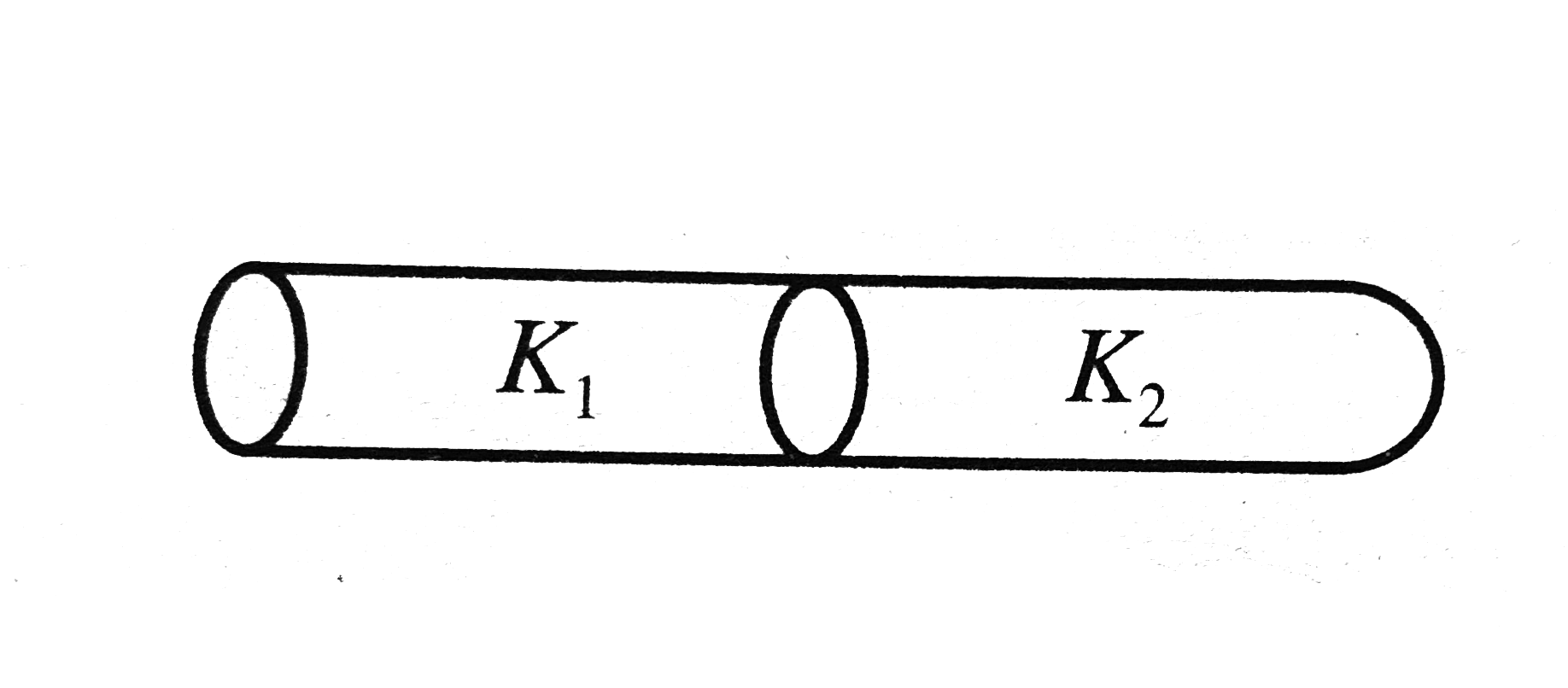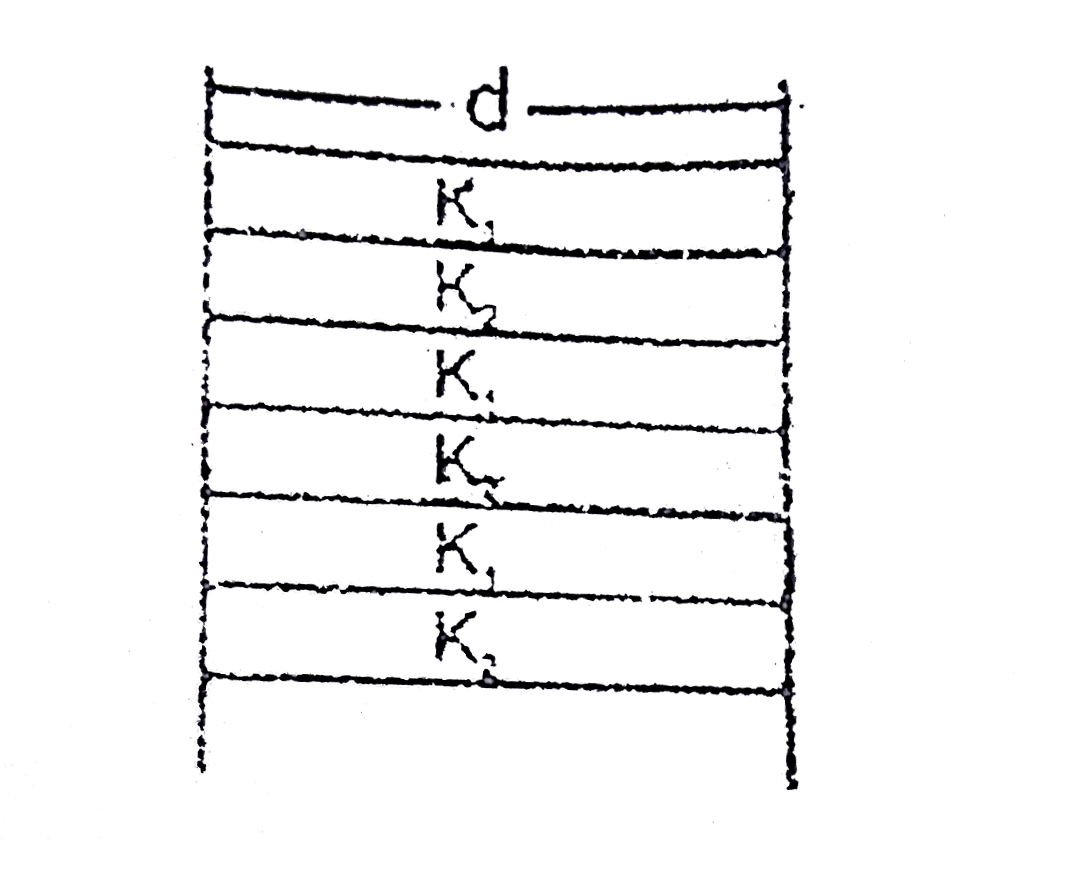IF two metallic plates of equal thickness and thermal conductivities are put together face to face anda common plate is constructed, then the equivalent thermal conductivity of this plate will be
The correct Answer is:B
To find the equivalent thermal conductivity Keq of two metallic plates with equal thickness and thermal conductivities K1 and K2 placed face to face, we can follow these steps:
Step 1: Understand the Setup
We have two plates:
- Plate 1 with thermal conductivity K1
- Plate 2 with thermal conductivity K2
Both plates have the same thickness L and cross-sectional area A.
Step 2: Apply Fourier's Law of Heat Conduction
According to Fourier's law, the heat transfer Q through a material is given by:
Q=K⋅A⋅ΔTL
where ΔT is the temperature difference across the material.
Step 3: Define the Temperature Difference
Let:
- The temperature at one end of Plate 1 be T1
- The temperature at the junction (interface) of the two plates be T
- The temperature at the end of Plate 2 be T2
The temperature differences for the two plates are:
- For Plate 1: ΔT1=T1−T
- For Plate 2: ΔT2=T−T2
Step 4: Write the Heat Transfer Equations
For Plate 1:
Q=K1⋅A⋅T1−TL
For Plate 2:
Q=K2⋅A⋅T−T2L
Step 5: Set the Heat Transfer Equal
Since the heat transfer Q is the same through both plates (steady state), we can set the equations equal to each other:
K1⋅A⋅T1−TL=K2⋅A⋅T−T2L
Step 6: Simplify the Equation
Cancel out A and L from both sides:
K1(T1−T)=K2(T−T2)
Step 7: Rearrange the Equation
Rearranging gives:
K1T1−K1T=K2T−K2T2
K1T1+K2T2=(K1+K2)T
Step 8: Solve for the Junction Temperature T
From the above equation, we can express T:
T=K1T1+K2T2K1+K2
Step 9: Find the Equivalent Thermal Conductivity
The equivalent thermal conductivity Keq can be defined as:
Q=Keq⋅A⋅T1−T2L
Substituting T into this equation and simplifying will lead us to:
T1−T2L=(T1−T)+(T−T2)L
Substituting the expressions for T1−T and T−T2 gives:
T1−T2L=QKeq⋅A
Step 10: Final Expression for Keq
After manipulating the equations, we find:
1Keq=1K1+1K2
Thus, the equivalent thermal conductivity is given by:
Keq=2K1K2K1+K2
Conclusion
The equivalent thermal conductivity of the combined plate is:
Keq=2K1K2K1+K2
We have two plates:
- Plate 1 with thermal conductivity K1
- Plate 2 with thermal conductivity K2
Both plates have the same thickness L and cross-sectional area A.
According to Fourier's law, the heat transfer Q through a material is given by:
Q=K⋅A⋅ΔTL
where ΔT is the temperature difference across the material.
Let:
- The temperature at one end of Plate 1 be T1
- The temperature at the junction (interface) of the two plates be T
- The temperature at the end of Plate 2 be T2
- For Plate 1: ΔT1=T1−T
- For Plate 2: ΔT2=T−T2
For Plate 1:
Q=K1⋅A⋅T1−TL
For Plate 2:
Q=K2⋅A⋅T−T2L
Since the heat transfer Q is the same through both plates (steady state), we can set the equations equal to each other:
K1⋅A⋅T1−TL=K2⋅A⋅T−T2L
Cancel out A and L from both sides:
K1(T1−T)=K2(T−T2)
Rearranging gives:
K1T1−K1T=K2T−K2T2
K1T1+K2T2=(K1+K2)T
From the above equation, we can express T:
T=K1T1+K2T2K1+K2
The equivalent thermal conductivity Keq can be defined as:
Q=Keq⋅A⋅T1−T2L
Substituting T into this equation and simplifying will lead us to:
T1−T2L=(T1−T)+(T−T2)L
Substituting the expressions for T1−T and T−T2 gives:
T1−T2L=QKeq⋅A
After manipulating the equations, we find:
1Keq=1K1+1K2
Thus, the equivalent thermal conductivity is given by:
Keq=2K1K2K1+K2
The equivalent thermal conductivity of the combined plate is:
Keq=2K1K2K1+K2
Topper's Solved these Questions
- BOOK - ICSECHAPTER - COMPETITION CARE UNITEXERCISE - THERMAL RADIATION13videos
COMPETITION CARE UNIT
- BOOK - ICSECHAPTER - COMPETITION CARE UNITEXERCISE - OSCILLATIONS23videos
COMPETITION CARE UNIT
- BOOK - ICSECHAPTER - COMPETITION CARE UNITEXERCISE - INTERNAL ENERGY40videos
COMPETITION CARE UNIT
- BOOK - ICSECHAPTER - CIRCULAR MOTION EXERCISE - MODULE 2 (FROM ROTATIONAL KINETIC ENERGY , WORK ,POWER)24videos
CIRCULAR MOTION
- BOOK - ICSECHAPTER - DIMENSIONSEXERCISE - SELECTED PROBLEMS (FROM CONVERSIONS OF ONE SYSTEMS OF UNITS INTO ANOTHER)9videos
DIMENSIONS
Similar Questions
A composite slab is prepared by pasting two plates of thickness L1 and L2 and thermal conductivities K1 and K2 . The slab have equal cross-sectional area. Find the equivalent conductivity of the composite slab.
View SolutionTwo identical plates with thermal conductivities K and 3K are joined together to form a single plate of double thickness. The equivalent thermal conductivity of one composite plate so formed for the flow of heat through its thickness is.
View SolutionA composite slab is made of two parallel layers of two different materials of thermal conductivities K1andK2 are of same thickness. Show that the equivalent thermal conductivity of the slab is 2K1K2K1+K2
View SolutionTwo rods of length l1andl2 and coefficients of thermal conductivities k1andK2 are kept touching each other. Both have the same area of cross-section. The equivalent of thermal conductivity is
View SolutionTwo rods of length d1 and d2 and coefficients of thermal conductivites K1 and K2 are kept touching each other. Both have the same area of cross-section. The equivalent thermal conductivity.
View SolutionConsider a compound slab consisting of two different material having equal thickness and thermal conductivities K and 2K respectively. The equivalent thermal conductivity of the slab is
View SolutionConsider a compound slab consisting of two different material having equal thickness and thermal conductivities K and 2K respectively. The equivalent thermal conductivity of the slab is
View Solution
Statement I: Two solid cylindrical rods of identical size and different thermal conductivity K1 and K2 are connected in series. Then the equivalent thermal conductivity of two rods system is less than that value of thermal conductivity of either rod.
Statement II: For two cylindrical rods of identical size and different thermal conductivity K1 and K2 connected in series, the equivalent thermal conductivity K is given by 2K=1K1+1K2View Solution
Statement I: Two solid cylindrical rods of identical size and different thermal conductivity K1 and K2 are connected in series. Then the equivalent thermal conductivity of two rods system is less than that value of thermal conductivity of either rod.
Statement II: For two cylindrical rods of identical size and different thermal conductivity K1 and K2 connected in series, the equivalent thermal conductivity K is given by 2K=1K1+1K2View SolutionA wall consists of alternating blocks withlength 'd' and coefficient of thermal conductivity k1 and k2. The cross sectional area of the blocks are the same. The equivalent coefficient of thermal conductivity of the wall between left and right is:-
 View Solution
View Solution

